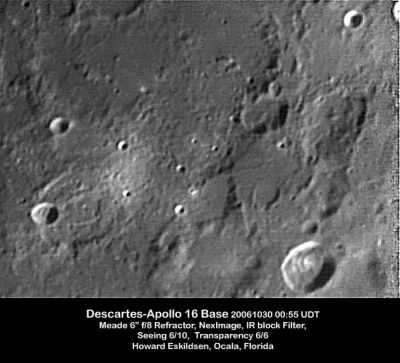Descartes
Contents
Descartes
|
Lat: 11.7°S, Long: 15.7°E, Diam: 48 km, Depth: 0.85 km, [/R%C3%BCkl%2045 Rükl: 45] |
Table of Contents

Howard Eskildsen; Descartes is the crater at lower left with a bright crater on its rim.
Images
LPOD Photo Gallery Lunar Orbiter Images Apollo Images Wes Higgins Lunar Image of the Week 04/14/2009
WARNING: the name Descartes is mentioned on many orbital frames of Apollo 12's three stereo-strips 56-B, 56-C, and 56-D. In fact, most of these frames don't show Descartes at all! All the frames of these three stereo-strips show the same caption: DESCARTES - LALANDE - MCCLURE - THEOPHILUS (which seem to have been four of the most important "landmarks" on these stereo-strips).- DannyCaes DannyCaes Aug 15, 2010
Maps
([/LAC%20zone LAC zone] 78D2) LAC map Geologic map LM map LTO map
Description
Description: Elger
([/IAU%20Directions IAU Directions]) DESCARTES.--This object, about 30 miles in diameter, situated N.E. of [/Abulfeda Abulfeda], is bounded by ill-defined, broken, and comparatively low walls; interrupted on the S.W. by a fine crater, Descartes A, and on the S.E. by another, smaller. There is also a brilliant crater outside on the N.E. Schmidt shows a crater-row on the floor, which I have seen as a cleft.
Description: Wikipedia
Additional Information
- Depth data from [/Kurt%20Fisher%20crater%20depths Kurt Fisher database]
- Pike, 1976: 0.85 km
- Westfall, 2000: 0.85 km
- Cherrington, 1969: 0.91 km
- The bright spot extending from Descartes' north rim has been identified as a small [/swirl swirl] with a magnetic field.
- Satellite craters Descartes A and C are on the [/ALPO%20list%20of%20bright%20ray%20craters ALPO list of bright ray craters].
- Satellite crater Descartes A is on the [/ALPO%20list%20of%20banded%20craters ALPO list of banded craters]
Ruins of a very ancient large crater north of Descartes
- North of Descartes there seems to be a circle-shaped arrangement of elevations that looks more-or-less like the ruins of a large crater the size of Hipparchus. This circle-shaped tendency is depicted on SLC map C5 (System of Lunar Craters, 1966). How much of this ancient crater could be observed during low-sun circumstances? - DannyCaes DannyCaes Jan 21, 2017
Nomenclature
- René Descartes (March 31, 1596 – February 11, 1650) was a highly influential French philosopher, mathematician, scientist, and writer. Dubbed the "Father of Modern Philosophy", and the "Father of Modern Mathematics", he was one of the key figures in the Scientific Revolution.
- According to Ewen A. Whitaker's book Mapping and Naming the Moon, the name Descartes was first used by Van Langren, and later by Madler (see Madler's list on page 220, and notes). However, in this book, the name Descartes seems absent in Van Langren's list, or was it the name Cartesii, which became the IAU's Romer? - DannyCaes DannyCaes Sep 30, 2014
- The USGS's Geologic Map of Part of the Descartes Region (I-748 B) shows the unofficial name Descartes Mountains (northeast, east, and southeast of Apollo 16's landing site).- DannyCaes DannyCaes Feb 19, 2014 (see also Chart 12 in the 21st Century Atlas of the Moon, Charles A. Wood/ Maurice J.S. Collins).
- Perhaps related: the Cartesio-Cayley zone, a scientific informal name which pop'd up in several professional papers made before and after the landing of Apollo 16's LM Orion north of Descartes. - DannyCaes DannyCaes Aug 15, 2015
LPOD Articles
Still Mysterious After All These Years
Lunar 100
[/Lunar%20100 L64]: Apollo 16 landing site; putative region of highland volcanism.
Bibliography
Wood, C.A. Apr. 2002. Mysterious Descartes. S&T April 2002 v103 p104
APOLLO OVER THE MOON; A VIEW FROM ORBIT, Chapter 3: The Terrae (Part 2), Figure 45.
This page has been edited 1 times. The last modification was made by - tychocrater tychocrater on Jun 13, 2009 3:24 pm - afx2u2